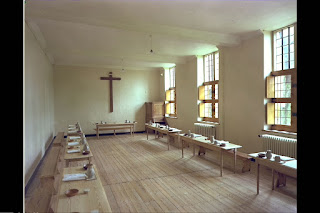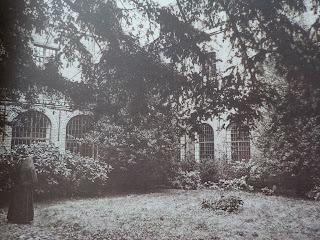Tervuren Park is one of the favourite spots for the residents of Brussels. The combination of water, forests and a grand edifice of the Africa Museum renders it an oasis of rest. Those exploring the area will find here the remains of a majestic castle that once stood here. Originally the residence of the dukes of Brabant in the XIV and XV centuries, it became one of the country residences of the Sovereigns of the Spanish Netherlands the Archduchess Isabel Clara Eugenia (1566-1633) and her husband the Archduke of Austria Albert VII (1559-1621).
But as you venture further into the forest, lacking in the knowledge of the history of the area you are unlikely to find other traces of the Infanta's heritage. These traces are very faint. But, it is rewarding to discover them - little, fading glimpses of the past; reminders of historical changes that have transformed Belgium's landscape over the centuries.
 |
| Tervuren castle, Jan Brueghel the Elder (1568-1625) |
I suppose not many people walking through the part of Tervuren Park, called Bois des Capucins, or Kapbos, ask themselves why it is called the Capuchin Forest. Fewer still venture off the Kapucijnendreef or the Drève des
Capucins. If you come across what appear to be a line of red bricks beneath your feet, you may like to exit the pathway and explore the land around you.
Covered under a canopy of grass you'll discover remains of what appear to be either foundations or ground-level chambers of buildings that once stood here.
Covered under a canopy of grass you'll discover remains of what appear to be either foundations or ground-level chambers of buildings that once stood here.
They are the faint remains of the Capuchin Monastery. (I was only able to find these ruins thanks to modern and older maps, as well as GPS.)

Built in 1626-1627, the Capuchin monastery did not last long. Like many monastic institutions on the territory of the Habsburg Netherlands, it fell victim to the decree by the Holy Roman Emperor Joseph II that contemplative monasteries, which he saw as "unproductive", had to close down. The anti-clerical fury of the French Revolution that swept across the Austrian domains dealt a final death blow. As a result, by 1798 the Capuchin monastery ceased to exist. An expert in ecclesiastical architecture, Joris Snaet of the Catholic University of Leuven, writes that the monastery was "completely destroyed.“ While at it, Joseph II also took the trouble to demolish the castle of Tervuren.
Joris Snaet's study, entitled "Isabel Clara Eugenia and the Capuchin Monastery at Tervuren” (in Cordula van Wyhe, ed., Isabel Clara Eugenia: Female Sovereignty in the Courts of Madrid and Brussels, 2011) has helped me piece together the story of this place.
As Snaet
writes: “the monastery was Isabella’s last great monastic
foundation. She assisted at the laying of the first stone of the
monastery [on 25 June 1626, together with Archbishop Jacobus Boonen of
Mechelen] and at the consecration of the church. The monastery was intended primarily as a seminary for Capuchin novices. A small hermitage was
specially constructed for her in the garden.” Thus, there was a royal
connection between the archducal castle, one of three (also the Coudenberg Palace in Brussels and Mariemont) favored by Archduchess Isabel and the monastery. Isabel would
often retire here for a few hours or days of spiritual retreat or in preparation for religious feasts. Her withdrawal became more frequent after she became a widow. According
to Snaet, the "Tervuren monastery was one of the rare Capuchin
monasteries in the Southern Netherlands to be located outside the walls
of a city.” This owes exactly to the patronage by the court in Brussels.
We learn from Snaet that the monastery “is one of two Capuchin foundations, the other being the
one in Brussels, established in 1587, to which Antonius Sanderus
dedicated a chapter in his famous Chorographia sacra Brabantiae (see an engraving, which appeared in this book, by Lucas Vorsterman, the chief engraver for Rubens). The fact that this celebrated
Flemish historian would devote a chapter to it attests to the
importance this monastery once had.
The founding of this institution enjoyed the support of several esteemed Belgian families. At its consecration were such distinguished individuals as “the Duke and Duchess of Aarschot, the Prince of Chimay, the Count and Countess of Gamalerio, the Count of Bugnon, the Count of Destaires, the Count of Roeulx, the Countess of Grimbergen and many others. All had made donations to the monastery.”
The founding of this institution enjoyed the support of several esteemed Belgian families. At its consecration were such distinguished individuals as “the Duke and Duchess of Aarschot, the Prince of Chimay, the Count and Countess of Gamalerio, the Count of Bugnon, the Count of Destaires, the Count of Roeulx, the Countess of Grimbergen and many others. All had made donations to the monastery.”
The
monastery was dedicated to ‘Saint Francis in the Desert.’ St. Francis
is the patron saint of – among others – the environment. He is also considered a model for interreligious dialogue. He gained such a reputation due to his meeting with the caliph of Egypt. Admittedly, Francis wanted to convert him to Christianity, but, unlike the warring Crusaders, he approached the caliph non-belligerently. The two had a dialogue. We know thanks to researcher
Eelco Diederik Nagelsmit that Franciscan spirituality was widespread in
the XVII century Flanders [Venite & videte: art and
architecture in Brussels as agents of change during the counter
reformation, c. 1609-1659, Universiteit Leiden, 2014].
This Capuchin monastery holds another interesting connection to Belgian history. In 1626, 1627-1630 and 1633-1635 its superior - and probably also its architect - was Carolus of Brussels van Arenberg.
As the son of
Anne de Croÿ, 5th
duchess of Aarschot (1563-1635), he came from one the finest Belgian families. After 1633, Carolus was suspected of
“quietly supporting” his brother Philip, duke of Aarschot, in the
Conspiracy of the Nobles to overthrow the Spanish rule. As a
consequence, in 1637, he was expelled from the Spanish Netherlands, and allowed to return only in 1643 (meanwhile, his
brother had died in detention in Madrid in 1640). While Carolus
eventually reconciled with the Spanish crown, he remained deeply
attached to the sovereignty of his family. The
first superior of the Capuchin monastery might therefore be
considered a Belgian patriot.
This Capuchin monastery holds another interesting connection to Belgian history. In 1626, 1627-1630 and 1633-1635 its superior - and probably also its architect - was Carolus of Brussels van Arenberg.
 |
| Portrait of capuchin friar Carolus van Arenberg by Paulus Pontius after Abraham van Diepenbeek |
 |
| Capuchin monastery at Tervuren, Lucas van Uden (1595-1672) |
































